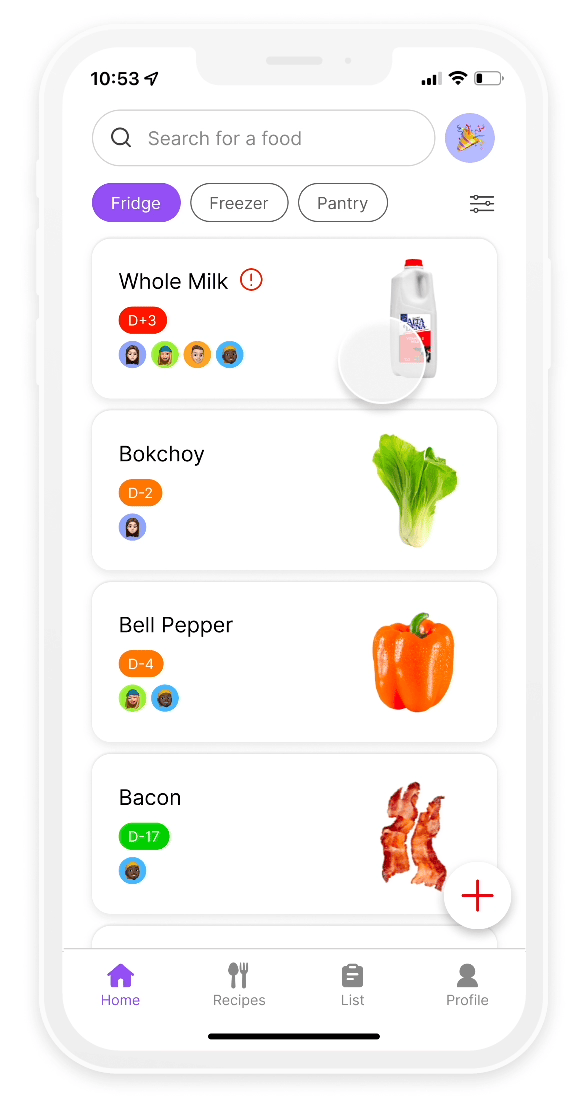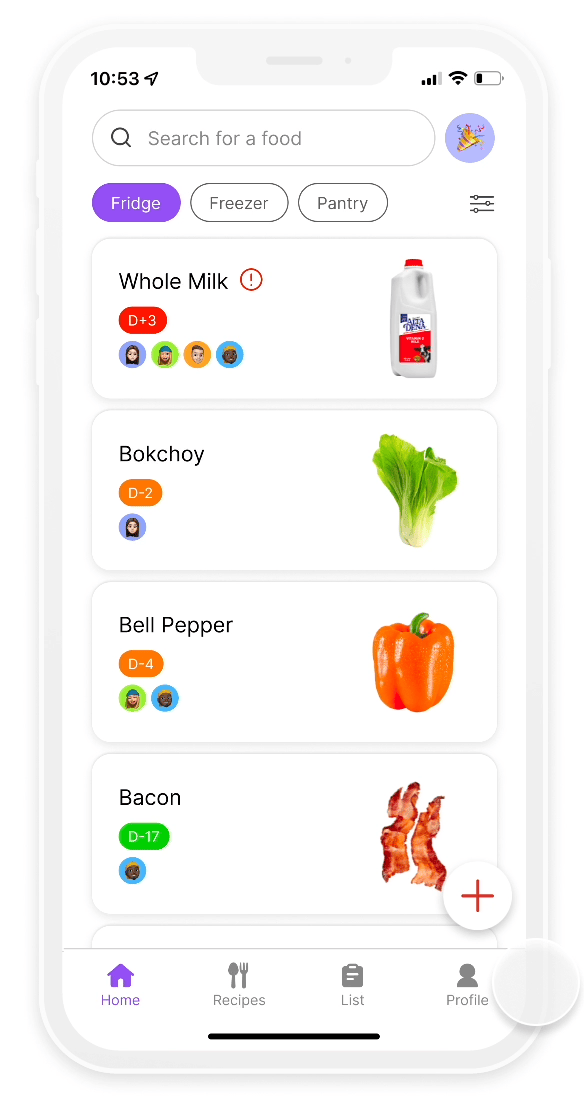
FoodFolio
Helping college students reduce food waste
As a college student, I've come to realize the significant waste generated by fellow students, prompting me to initiate my own project to explore and identify potential solutions.
TYPE
Independent Project
TIMELINE
March 2023
TOOLS
Figma
DISCIPLINE
UX Research
UI Design
1.4 billion tons of edible food is wasted every year.
Young adults aged 18-24, including college students, are among the most significant contributors to this waste.
THE CHALLENGE
How might we optimize grocery usage for college students?
CONTEXT
Overview
But why are college students among the largest contributors to food waste?
RESEARCH GOALS
Outlining my research goals guided my research methods and questions.
RESEARCH METHODS
To discover the current gifting experience landscape, my research methods were:
01
Research
surveys
user interviews
I targeted college students and obtained 23 survey responses to investigate the causes of food waste.
Additionally, I conducted 4 user interviews to gain deeper insights into their schedules and underlying factors contributing to food waste among this group.
01 Understand the amount of food college students waste
02 Understand why food waste occurs among college students
03 Identify what daily factors contribute to food waste
KEY INSIGHTS
Using affinity maps, I synthesized my research and summarized my findings into six key insights.
02
Synthesis
INSIGHT #1
Students struggle to remember all the groceries in their fridge, especially when sharing fridges
INSIGHT #2
Students overlook expiration dates and forget about the foods they need to consume before they go bad
INSIGHT #3
Many groceries purchased are unplanned and are impulse purchases
INSIGHT #4
Students understand the negative effects of food waste and feel a level of guilt when throwing out food
INSIGHT #5
Unplanned meals out make it more difficult to accurately plan eating at home
INSIGHT #6
Due to their busy lifestyles, college students seek fast and convenient access to food
USER PERSONAS
To ensure a user-centric solution, I created user personas in order to better empathize with the different groups.
JOURNEY MAPS
Focusing on The Forgetful Chef persona, I laid out the weekly tasks of this persona. By creating a journey map for this persona, I further empathized with the users in each step of the journey.
03
Ideation
Through Brainwriting and a Prioritization Matrix, I narrowed down my solution to a mobile application that allows users to collaboratively track the groceries they own along with the expiration status and optimize grocery usage.
USER FLOWS
From my synthesis, I created user flows to visualize the journey a user can take on the app. This allowed me to ideate the layout and different features to add to the solutions.
The three user flows— Homes, Recipes, and Shopping List—are the different pages on the app.
FINAL DESIGNS
A
Keep track of your groceries
As students tend to forget the foods they have at home, I developed a solution that enables you to view all the contents of your refrigerator, freezer, and pantry in a quick glance.
You can also search for a specific item, allowing you to quickly verify whether you have a particular ingredient while you are out grocery shopping.
To add new groceries, you can take a picture of a receipt, scan barcodes of individual items, or manually add items.
Know when your groceries will expire
With visual indicators, you can stay informed about the expiration status of your groceries.
The plus or minus along with the numbers in the tags display the expiration date.
That milk is definitely starting to get smelly…
Pressing on each item provides you with a more clear indication of whether a certain food item has expired or when it will expire, as it will be fully written out as 'Expired' or 'Expires in'.
Collaborate with your housemates
Considering that 87% of undergraduate students live with roommates or family members (National Center for Education Statistics), I incorporated a collaborative feature.
You can create a new “Home” for each of your living spaces and invite your housemates to join, giving you all the ability to view the entire inventory of groceries within the shared group.
Within the shared group, you can easily differentiate your groceries from those of your housemates by identifying the owner of each item.
Additionally, you can choose to share specific food items with your housemates by selecting multiple owners for an item.
I guess everybody in this house likes Tostitos Hint of Lime Chips
Filter by people and expiration status
Given the long list of groceries, it can become challenging to distinguish whose groceries belong to whom. To address this, I incorporated a filter that enables you to select whose groceries you wish to view.
Additionally, you can filter the list based on the expiration status of the items, providing you with a more organized and convenient grocery management experience.
Get suggested recipes with ingredients you own
By selecting the house you are cooking at and who you’re cooking with, you are suggested recipes that can be made using the ingredients available to those users.
This simplifies the process of deciding what to cook and ensures that you can make proper meals with the ingredients on hand, rather than resorting to eating random items lying around the house or feeling like there is nothing to eat.
Create a shopping list
Considering that students often engage in impulsive grocery shopping, resulting in unnecessary purchases, I incorporated a shopping list feature to promote intentional shopping.
You can create a checklist of items to buy when you go grocery shopping, preventing you from buying things you don't need. This feature also makes my solution a one-stop-shop for all your grocery-related needs.
WHAT I LEARNED
Solutions don’t need to answer all research insights
While designing a solution, I encountered difficulty in addressing ALL the insights from my research. Undertaking a hypothetical independent project granted me the freedom to tackle as many insights as I could. However, I still couldn't address all the insights, and I've come to learn that it's acceptable for my solution to only address a few problems as it is nearly impossible for a design solution to resolve 100% of users' issues.
The Human-Centered Design process and tools should be used as applicable
Reflection
The HCD process involving research, synthesis, ideation, and design serves as a standard process for a design project. There are also many tools to use throughout the process such as affinity maps, user personas, journey maps, user flows. etc. However, this project has shown me that not every design project needs to follow the prescribed formula or every tool.
When I was crafting journey maps, I found myself questioning whether I was creating them out of genuine necessity or simply because I was following a predefined process. Through this project, I learned that each project is unique and may require its unique set of tools and processes.
SEE MORE PROJECTS

















